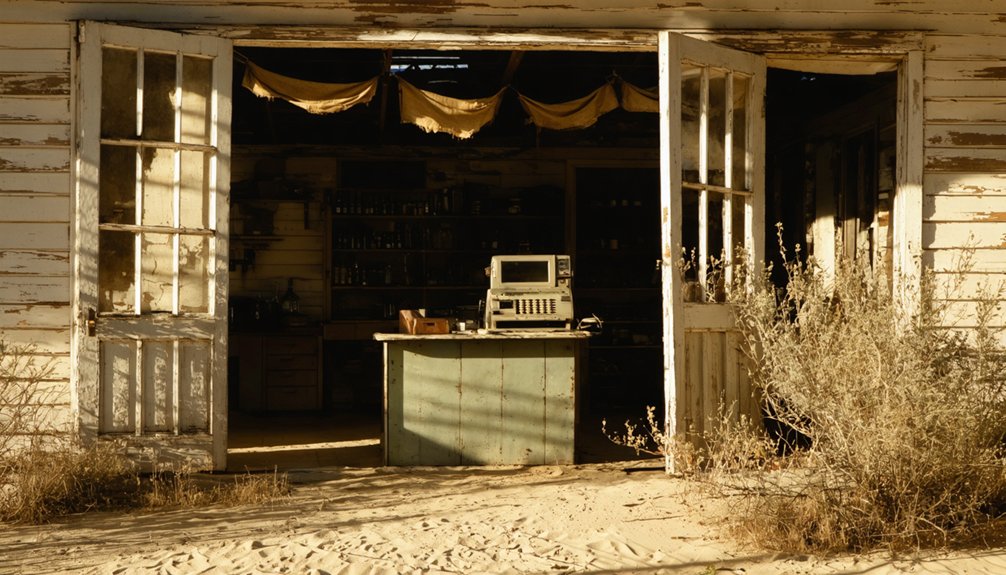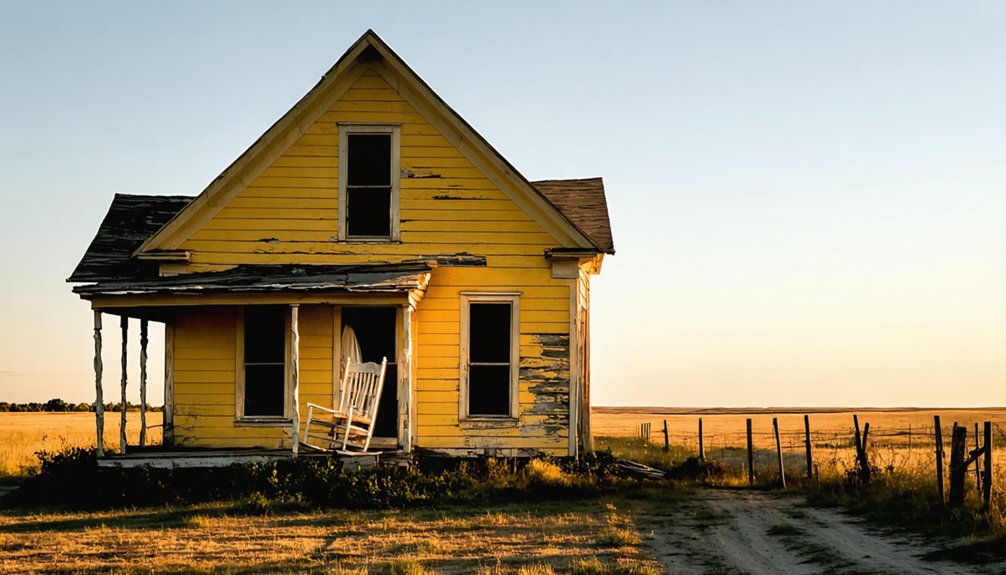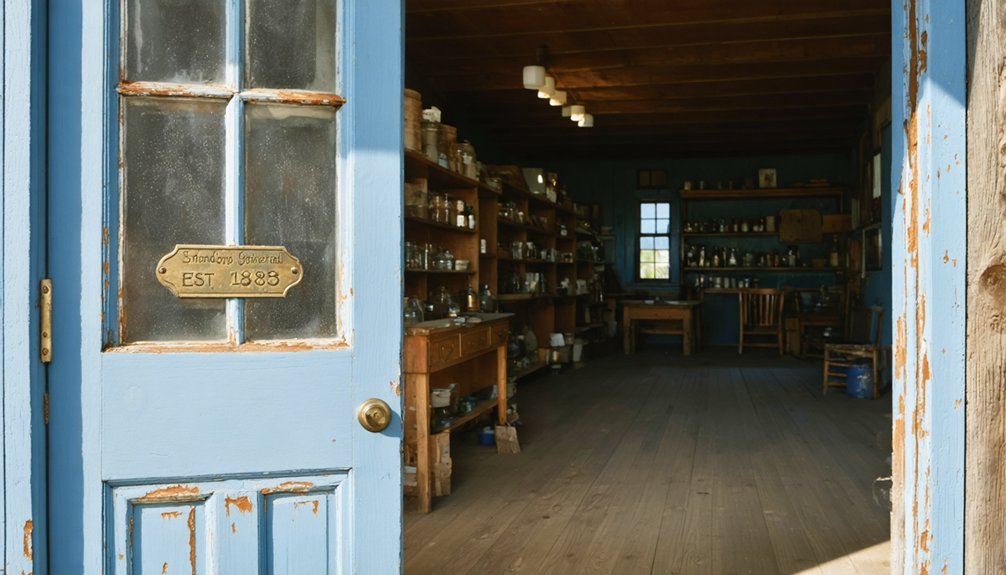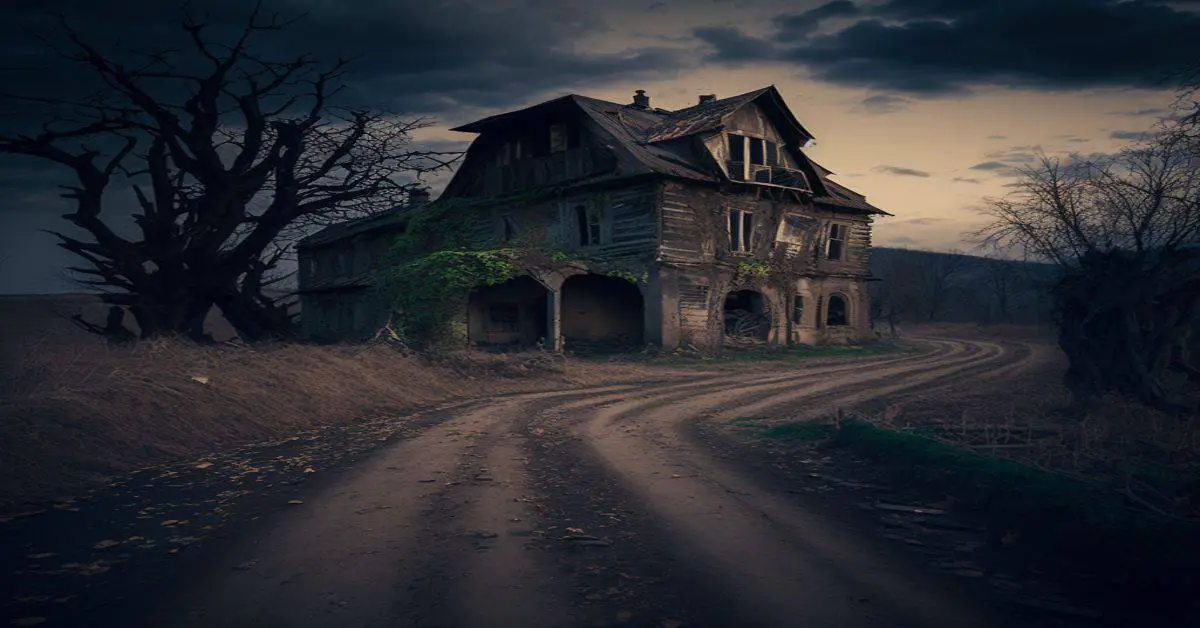You’ll find Daggett’s remnants five miles south of Mount Carroll along Illinois Route 78. This ghost town, established by Adam Daggert in the early 1830s, once thrived as an agricultural service center with a post office, railroad depot, and general stores. Robert Daggitt expanded the settlement in 1837, acquiring 3,000 acres and establishing the Daggitt Cemetery. While commercial activity declined after 1909, the town’s rich history of Methodist English and Lutheran German settlers holds fascinating untold stories.
Key Takeaways
- Daggett was established in the 1830s by Adam Daggert and expanded by Robert Daggitt, becoming a small agricultural service center.
- Located five miles south of Mount Carroll along Illinois Route 78, the town served Carroll County’s farming community.
- The town featured a post office, railroad depot, blacksmith, general stores, one-room schoolhouse, and Trinity Lutheran Church.
- Commercial decline began after 1909 due to railroad service cuts, with the town reduced to a flag stop by 1924.
- The last remaining businesses closed by 1927, transforming Daggett into a ghost town with environmental challenges from mining activity.
The Pioneer Settlement Years
During the early 1830s, Adam Daggert and his family established the foundations of what would become Daggett, Illinois, when they settled near present-day Timberlake and Daggert roads in Carroll County.
You’ll find that these early pioneers faced countless hardships as they carved out their existence in the untamed Illinois frontier.
Robert Daggitt joined the settlement in 1837, expanding his influence as both carpenter and farmer until his land holdings reached up to 3,000 acres. The family later established a burial ground charging neighbors one dollar per grave.
The settlement drew primarily Methodist English and Lutheran German settlers, who brought their community traditions from Connecticut, Ohio, and Indiana.
Together, they created a close-knit Protestant community that would shape the region’s character through shared religious values and cooperative farming practices.
Adam Daggert donated land where Trinity Lutheran Church stands today.
Location and Regional Significance
Located five miles south of Mount Carroll along modern Illinois Route 78, the ghost town of Daggett once occupied a strategic position within Carroll County’s agricultural heartland.
You’ll find the site at coordinates 42°01′57″N 89°58′25″W, nestled in rolling upland terrain typical of northern Illinois’s Driftless Area periphery.
The settlement’s position along key transportation routes made it briefly viable as a commercial hub. You can trace Daggett’s footprint where historic rail lines and rural roads once connected local farmers to regional markets. Users researching the area should note that some historical references may lead to disambiguation pages for clarification.
The surrounding landscape, with its fertile soil and gentle slopes under 1,000 feet elevation, supported the agricultural practices that defined the area’s economy.
The area bears similarities to nearby communities like Ingalls and Stephenson, which share the region’s rural character.
The Daggert homestead‘s original boundaries remain visible near the intersection of today’s Timberlake and Daggert roads.
Economic Life and Community Development
As railroad service reached Salem Township in the late 19th century, Daggett emerged as an essential agricultural service center supporting the region’s farming community.
You’d have found a bustling post office, railroad depot, blacksmith, and small stores serving local farmers’ needs, while a one-room schoolhouse and church fostered community cohesion.
The town’s economic resilience faced challenges after 1909 when railroad service cuts began diminishing commercial activity.
By 1924, Daggett had become just a flag stop, though two general stores persisted through 1927.
The town’s decline accelerated when railroad maintenance operations shifted to Barstow, which offered superior transportation links.
Like many settlements in Illinois that depended on ferry crossings, the town’s importance diminished as transportation networks evolved.
While Route 66 briefly sustained some through traffic, Interstate 40’s construction in the 1960s further isolated this once-vital agricultural hub.
The area’s economic struggles paralleled the end of the borax mining operations, leading to widespread job losses in the region.
The Daggitt Cemetery Legacy
If you visit Daggitt Cemetery today, you’ll find a pioneer burial ground that Robert Daggitt established in the late 1830s as a half-acre family plot near present-day Lake Cook Road.
The cemetery grew to serve Protestant English and German settlers, including both marked and unmarked graves of epidemic victims and impoverished families who paid just $1 for burial plots.
Since Moraine Township took over the cemetery’s care in 1996, preservation efforts have helped maintain this important historical site that bridges Highland Park and Glencoe, though some early graves remain lost to time and neglect. The Glencoe Historical Society now offers guided cemetery tours that help visitors connect with this historic burial ground’s rich past.
Pioneer Burial Ground History
During the late 1830s, English immigrant Robert Daggitt established what would become one of northern Illinois’ most significant pioneer burial grounds after losing three of his children to disease and accident.
You’ll find this half-acre cemetery near today’s Braeside Metra station, where early pioneer funerary practices reflected the harsh realities of frontier life. The land was officially transferred to Nathaniel Daggett through a February 1867 purchase from John B and Olive Denny.
- Daggitt charged $1 per grave and welcomed Protestant settlers, particularly English Methodists and German Lutherans.
- The cemetery’s earliest marked graves from 1845 belong to Daggitt’s daughters Ann and Rachel, who succumbed to tuberculosis.
- During the 1850s cholera epidemic, burial customs adapted as impoverished families conducted nighttime burials in unmarked plots.
- The site’s location near a Lutheran church along County Line Road served both Lake and Cook county residents, highlighting the area’s fluid community boundaries.
Cemetery Preservation Since 1996
Once neglected and vandalized for decades, Daggitt Cemetery found new life in 1996 when Deerfield Township (now Moraine Township) took responsibility for its preservation through collaborative efforts with Highland Park’s City and Park District. The cemetery’s management echoes how Old Route 66 enhances accessibility to historical burial grounds.
From 2020 to 2023, you’ll find evidence of extensive cemetery restoration work, including water-cleaned headstones, epoxy-repaired markers, and reconstructed bases.
The restoration revealed previously unreadable inscriptions and unknown graves, like Margaretha Rudolph’s marker that was pieced together from four fragments.
While historical documentation before 1996 relied on inconsistent, typed index cards, today’s records incorporate online databases and property information systems.
Though no new plots have been sold since 2005, the township’s ongoing preservation efforts continue to uncover and protect this essential piece of local heritage.
Natural Challenges and Environmental Impact

While Daggett’s transformation into a ghost town reflects the broader decline of Illinois coal mining, the environmental legacy of this industry continues to plague the region. The area faces significant challenges that’ll require extensive environmental restoration and pollution mitigation efforts.
- You’ll find abandoned mine sites leaching harmful contaminants into local groundwater and streams, threatening both wildlife and nearby communities with acid mine drainage containing arsenic and lead.
- The stripped landscape struggles to support native vegetation, leaving vast areas vulnerable to erosion and invasive species. Similar to DePue’s toxic slag that was used for paving village streets, contaminated mine waste was repurposed throughout Daggett’s development.
- Surface water pollution persists decades after mining ceased, degrading aquatic ecosystems and limiting water use.
- Recent federal funding through the Bipartisan Infrastructure Law offers hope for cleanup, but full recovery will take years of dedicated reclamation work.
Decline and Abandonment
As Daggett entered the 1910s, the town’s gradual decline accelerated through a series of devastating blows to its transportation infrastructure.
You’d have seen daily train service cut from multiple stops to just two in 1909, then to a single daily train by 1915. By 1924, you’d find Daggett reduced to a mere flag stop, dealing a fatal blow to the town’s connectivity.
The railroad’s steady retreat from Daggett spelled doom, as service dwindled from multiple daily trains to just an occasional whistle stop.
This transportation decline triggered a domino effect of closures.
You’ll notice how the town’s once-vibrant commercial district, which supported several stores in 1910, shrank to just two general merchandise shops by 1927. As community isolation intensified, essential institutions vanished – the post office, church, school, and blacksmith all shut down.
Notable Settlers and Local Stories

Among the area’s earliest pioneers, you’ll find Adam Daggert, who established a homestead in the 1830s near present-day Timberlake and Daggert roads.
Robert Daggitt, who arrived from England in the late 1830s, became a prominent carpenter and landowner, eventually controlling up to 3,000 acres that included parts of today’s Ravinia Park and Chicago Botanic Gardens.
The Daggitt family’s influence extended beyond agriculture, as Robert generously provided burial space for both family and impoverished neighbors during the 1850s cholera epidemic at what became the community’s chartered cemetery.
Pioneer Families and Founders
The pioneer settlement of Daggett traces its origins to Adam Daggert (later spelled Daggett) and his family, who established their homestead in Carroll County‘s untamed wilderness during the early 1830s.
Their pioneer resilience shaped what would become a small but enduring community near present-day Timberlake and Daggert roads in Mt. Carroll.
- You’ll find no evidence of earlier European-American settlers in the area before the Daggert family’s arrival.
- The family’s choice to settle here exemplified the quintessential pioneer spirit, seeking fertile farmland and independence.
- Their homestead became the nucleus of the community, creating lasting family legacies.
- Like many Midwestern pioneers, they transformed raw prairie into productive farmland, establishing the foundation for future generations.
Early Merchants and Traders
During the mid-1830s, pioneering merchants and traders established essential economic foundations in Daggett, bringing crucial services to this fledgling prairie settlement.
You’ll find that these early entrepreneurs adapted to harsh prairie conditions through merchant innovations like versatile general stores that served as community hubs along Lake Cook Road’s important trade networks.
Robert Daggitt’s extensive landholdings anchored the area’s commercial development, while local merchants supported their neighbors through challenges including cholera outbreaks and devastating prairie fires.
They’ve left an enduring legacy of entrepreneurial spirit, fostering a diverse community where craftsmen, farmers, and traders worked together.
Despite economic hardships, these resourceful merchants contributed to infrastructure development and community growth, often sponsoring local events and supporting early educational initiatives that shaped Daggett’s character.
Notable Community Leaders
While establishing Daggett’s foundations in the 1830s, pioneer Adam Daggert emerged as the settlement’s most influential leader, founding the town near what would become Timberlake and Daggert roads. His community leadership set the groundwork for the town’s development and agricultural growth.
Beyond Daggert’s influence, several key figures shaped the town’s brief but notable history:
- Local clergy who managed the church’s spiritual and social affairs
- Schoolteachers who provided education in the one-room schoolhouse
- Railroad depot managers who coordinated crucial transportation links
- Blacksmiths who supported the farming community through essential services
These agricultural influencers fostered cooperation among farmers and settlers, enabling shared harvests and mutual support that sustained Daggett’s population through the early 1900s.
Historical Preservation Efforts

Despite its historical significance as an early Illinois settlement, Daggett hasn’t benefited from any organized preservation initiatives.
You’ll find no historical markers, archaeological surveys, or dedicated preservation groups working to document or protect this former milling community near present-day Lockport Township.
The preservation challenges are substantial, as limited public records and a lack of surviving structures make it difficult to piece together Daggett’s complete story.
While local historical societies could potentially uncover more through land records and oral histories, no coordinated efforts have emerged.
The site’s inclusion in Illinois ghost town registers represents the only formal recognition of its existence.
The land where Daggett once stood has likely returned to agricultural use, with its early settlement history fading into obscurity.
Frequently Asked Questions
Are There Any Remaining Buildings or Structures From Daggett Still Standing Today?
While 90% of original structures are gone, you’ll find a few abandoned buildings still standing but in severe disrepair, including remnants of the stone Hotel awaiting historical preservation on private property.
What Happened to the Descendants of Daggett’s Original Settlers?
You’ll find most descendants relocated to nearby Carroll County towns like Mt. Carroll, while others spread across Illinois. Family legacies live on through historical records in local genealogies and heritage societies.
Were Any Famous Historical Figures Known to Have Visited Daggett?
You won’t find famous visitors to Daggett, Illinois, as historical records indicate it’s likely a mapping error. The historical significance you’re seeking actually relates to Daggett, California’s mining and transportation heritage.
Did Native American Tribes Have Settlements in the Daggett Area?
Time has drawn a veil over this mystery, as there’s no concrete evidence of Native tribes having permanent historical settlements in the Daggett area, though seasonal camps likely dotted the region’s landscape.
What Was the Peak Population of Daggett Before It Became Abandoned?
During peak growth in the early 1890s, you’d find between 300-500 people living there, with demographic changes driven by borax mining that employed 200 workers at its height.
References
- https://www.morainetownship.org/daggitt-cemetery-history
- https://www.youtube.com/watch?v=ZCx5D7GIUY4
- https://www.theroute-66.com/daggett.html
- https://will-ilgw.genealogyvillage.com/townships/1878lockporttwp.htm
- http://cantontornado36.blogspot.com/2017/04/ghost-towns-of-fulton-county-illinois.html
- https://www.youtube.com/watch?v=fy3yJDBA5nI
- https://en.wikipedia.org/wiki/List_of_ghost_towns_in_Illinois
- https://drloihjournal.blogspot.com/2022/05/lost-towns-of-illinois-daggert-illinois.html
- http://files.usgwarchives.net/co/eagle/bios/daggett88gbs.txt
- http://genealogytrails.com/ill/will/earlyhistory.html



